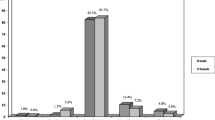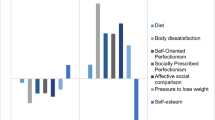Abstract
The aim of the present study was to investigate the prevalence of eating disorder (ED) traits among obese children and adolescents. The Swedish version of the Eating Disorder Inventory for Children, consisting of 11 subscales, was administered to 150 obese patients during an extensive investigation of causes and risk factors in obesity at the Karolinska University Hospital at Huddinge. Patients aged 17–18 years (N=24) had a mean body mass index (BMI) of 40.7, SD 5.31, and patients aged 8–16 (N=126) had a mean body mass index standard deviation score (BMI SDS) of 6.18, SD 1.69. These patients were compared with 201 girls with a diagnosed ED from the COEAT project and with a control group of schoolchildren. The comparison between obese girls and boys showed that adolescent obese girls scored higher than obese boys on Drive for Thinness, Bulimia and Body Dissatisfaction. They also scored higher on Ineffectiveness, Interoceptive Awareness and Impulse Regulation. Obese girls were close to the girls with an ED on six of the subscales. Obese boys had a lower score of Asceticism than boys in the control group. The conclusion is that psychological traits associated with disordered eating appear among obese patients, particularly among the girls. However, these patients rarely satisfy any diagnostic criteria for ED during childhood or adolescence. Since obesity treatment currently assumes rational behavior, i.e. no EDs, it is important to discover ED traits at an early age in order to adapt treatment accordingly.
Similar content being viewed by others
References
Whitaker R.C., Wright J.A., Pepe M.S., Seidel K.D., Dietz W.H.: Predicting obesity in young adulthood from childhood and parental obesity. N. Engl. J. Med., 337, 869–873, 1997.
Kiess W., Marcus C., Wabitsch M.: Obesity in childhood and adolescence. Karger, Basel, 2004.
Britz B., Siegfried W., Ziegler A., Lamertz C., Herpertz-Dahlmann B.M., Remschmidt H., Wittchen H.U., Hebebrand J.: Rates of psychiatric disorders in a clinical study group of adolescents with extreme obesity and in obese adolescents ascertained via a population based study. Int. J. Obes. Relat. Metab. Disord., 24, 1707–1714, 2000.
Gortmaker S.L., Must A., Perrin J.M., Sobol A.M., Dietz W.H.: Social and economic consequences of overweight in adolescence and young adulthood. N. Engl. J. Med., 14, 1008–1012, 1993.
Napolitano M.A., Head S., Babyak M.A., Blumenthal J.A.: Binge eating disorder and night eating syndrome: psychological and behavioural characteristics. Int. J. Eat. Disord., 30, 193–203, 2001.
Bulik C.M., Sullivan P.F., Kendler K.S.: An empirical study of the classification of eating disorders. Am. J. Psychiatry, 157, 886–895, 2000.
American Psychiatric Association. Diagnostic and Statistical Manual of Mental Disorders, 4th ed. (DSMIV). Washington, DC, American Psychiatric Association, 1994.
Hsu L.K.G., Mulliken B., NcDonagh B., Krupa Das S., Rand W., Fairburn C.G., Rolls B., McCrory M.A., Saltzman E., Shikora S., Dwyer J., Roberts S.: Binge eating disorder in extreme obesity. Int. J. Obes. Relat. Metab. Disord., 26, 1398–1403, 2002.
Decaluwé V., Braet C.: Prevalence of binge-eating disorder in obese children and adolescents seeking weight-loss treatment. Int. J. Obes. Relat. Metab. Disord., 27, 404–409, 2003.
Decaluwé V., Braet C., Fairburn C.G.: Binge eating in obese children and adolescents. Int. J. Eat. Disord., 33, 78–84, 2003.
Thurfjell B., Edlund B., Arinell H., Hägglöf B., Engström I.: Psychometric properties of Eating Disorder Inventory (EDI-C) in Swedish girls with and without an eating disorder. Eat. Weight Disord., 8, 296–303, 2003.
Rolland-Cachera M.F., Sempe M., Guilloud-Bataille M., Patois E., Pequignot-Guggenbuhl F., Fautrad V.: Adiposity indices in children. Am. J. Clin. Nutr., 36, 178–184, 1982.
Garner D.M.: The Eating Disorder Inventory-C. Lutz, FL, Psychological Assessment Resources, 1991.
Garner D.M.: The Eating Disorder Inventory-2. Professional manual. Odessa, FL, Psychological Assessment Resources, 1991.
Thurfjell B., Edlund B., Arinell H., Hägglöf B., Engström I.: Eating Disorder Inventory for Children (EDI-C): Effects of age and gender in a Swedish sample. Eur. Eat. Dis. Rev., 12, 256–264, 2004.
Garner D.M., Olmsted M.P., Polivy, J.: Development and validation of a multi-dimensional eating disorder inventory for anorexia nervosa and bulimia. Int. J. Eat. Disord., 2, 15–34, 1983.
Edlund B., Halvarsson K., Gebre-Medhin M., Sjödén P.O.: Psychological correlates of dieting in Swedish adolescents: A cross-sectional study. Eur. Eat. Disord. Rev., 7, 47–61, 1999.
Tyrka A.R., Waldron I., Graber J.A., Brooks-Gunn J.: Prospective predictors of the onset of anorexic and bulimic syndromes. Int. J. Eat. Disord., 32, 282–290, 2002.
Neumark-Sztainer D., Goeden C., Story M.: Association between body satisfaction and physical activity in adolescents: Implications for programs aimed at preventing a broad spectrum of weight-related disorders. Eat. Disord., 12, 125–137, 2004.
Goodman E., Whitaker R.C.: A prospective study of depression in the development and persistence of adolescent obesity. Pediatrics, 109, 497–504, 2002.
Stice E., Presnell K., Shaw H., Rohde P.: Psychological and behavioral risk factors for obesity onset in adolescent girls: A prospective study. J. Cons. Clin. Psychol., 73, 195–202, 2005.
Jaeger B., Ruggiero G.M., Edlund B., Gomez-Perretta C., Lang F., Mohammadkhani P., Sahleen-Veasey C., Schomer H., Lamprecht F.: Body dissatisfaction and its interrelations with other risk factors for bulimia nervosa in 12 countries. Psychother. Psychosom., 71, 54–61, 2002.
Striegel-Moore R.H., Dohm F.A., Pike K.M., Wilfley D.E., Fairburn C.G.: Abuse, bullying, and discrimination as risk factors for binge eating disorder. Am. J. Psychol., 159, 1902–1907, 2002.
Branson R., Protoczna N., Kral J.G., Lentes K.U., Hoehe M.R., Horber F.F.: Binge eating as a major phenotype of melanocortine 4 receptor gene mutations. N. Engl. J. Med., 348, 1096–1103, 2003.
Costa J.L., Brennen M.B., Hochgeschwender U.: The human genetics of eating disorders. Lessons from the leptin/melanocortin system. Child Adolesc. Psychiatr. Clin. North Am., 11, 387–397, 2002.
Epstein L.H., Paluch R.A., Saelens B.E., Ernst M.M., Wilfley D.E.: Changes in eating disorder symptoms with pediatric obesity treatment. J. Pediatr., 139, 58–65, 2001.
O’dea J.A.: Evidence for a self-esteem approach in the prevention of body image and eating problems among children and adolescents. Eat. Disord., 12, 225–239, 2004.
Wardle J., Waller J., Rapoport L.: Body dissatisfaction and binge eating in obese women: the role of restraint and depression. Obes. Res., 9, 778–787, 2001.
Stice E., Shaw H.: Eating Disorder Prevention Programs: A Meta-Analytic Review. Psych. Bull., 130, 206–227, 2004.
Johnson W.G., Grieve F.G., Adams C.D., Sandy J.: Measuring binge eating in adolescents: Adolescent and parent versions of the questionnaire of eating and weight patterns. Int. J. Eat. Disord., 26, 301–314, 1999.
Grilo C.M., Masheb R.M., Wilson G.T.: A comparison of different methods for assessing the features of eating disorders in patients with binge eating disorder. J. Consult. Clin. Psychol., 69, 317–322, 2001.
Author information
Authors and Affiliations
Corresponding author
Rights and permissions
About this article
Cite this article
Lundstedt, G., Edlund, B., Engström, I. et al. Eating disorder traits in obese children and adolescents. Eat Weight Disord 11, 45–50 (2006). https://doi.org/10.1007/BF03327743
Received:
Accepted:
Published:
Issue Date:
DOI: https://doi.org/10.1007/BF03327743




